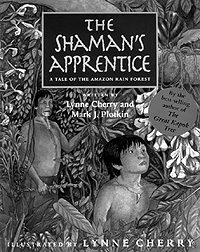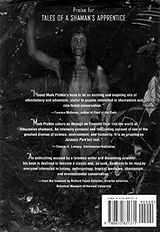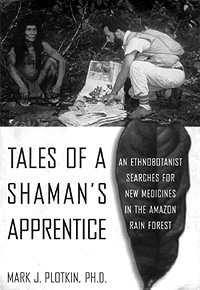
Not Just for Kids
The Shaman's Apprentice
A tale of the Amazon Rain Forest --Gulliver Green Books $16
by Lynne Cherry & Mark J. Plotkin Reviewed by Georgia Knoll
I think The Shaman's Apprentice is about how as life changes in many different ways, it is important to remember your roots and heritage.
The main character is Kamanya, who is the shaman's future apprentice. He is a boy who follows the shaman through his treks through the rain forest to see the medical wonders of some plants.
In the book, Kamanya's tribe encounters many changes in their way of life, but in the end they realize how important their heritage really is.
My favorite quote is Gabriela's saying to the chief and his people: "Now you have two books in your language - the Bible and this, the wisdom of Nahtahlah. Now your people will never forget the shaman's wisdom. Perhaps one day the people of the world may benefit from Natahlah's knowledge of healing powers of the rain forest."
I enjoyed The Shaman's Apprentice because I thought it was a good example of how important the rain forest is and why we need to do every thing we can to help preserve it.
I also enjoyed the illustrations. They were very detailed and beautifully done. The bright colors really bright life to the pages of the book.
Healing from the Jungle
Malaria comes from the jungle. Carried by mosquitoes into the blood, it sickens with terrible fever and chills. Also from the jungle comes the remedy still used to fight malaria: quinine, from the cinchona tree. Quinine has traveled around the world, and under its protection, colonists have explored and settled regions few would otherwise have dared to visit. The English used it to flavor a popular tropical drink. If you've tasted tonic water, you've tasted quinine.
Other Good Flavors from the Jungle
Chocolate, vanilla and cinnamon come from the Amazon, too.

When Mark Plotkin went to school, he learned a lot from his teacher. His teacher's name at Harvard University was Dr. Richard Schultes. Dr. Schultes had spent many years in South America with indigenous people the original people of the land learning about natural medicines.
For many Indian people, the jungle is their drug store. They make
medicines from tree bark and leaves. Guess what? About half of the medicines
in drug stores also come from jungles and rain forests.
Dr. Schultes had spent many years learning about natural medicines and how people in Amazon lands prepared them. When Mark took his class, he decided that he wanted to be like Dr. Schultes an ethnobotanist. A botanist is a scientist who studies plants, and an ethnobotanist is a scientist who studies the traditional use of plants in a culture.
Mark had many adventures meeting medicine men called shamans and learning their secrets. He says that every time a shaman dies, it's as if a library burned to the ground. He wrote a book called Tales of a Shaman's Apprentice that many people read.
Then he wrote The Shaman's Apprentice for kids. New Bay Times telephoned Mark at his home in Virginia and asked him some questions
with Mark Plotkin
Q. Why did you write this children's book?
A. Kids tend to be the best environmentalists. They have that fire in the belly that a lot of older people lose. Also, a lot of the books out there on this subject were wrong and I wanted one that was correct.
Q. How long did it take you to write The Shaman's Apprentice?
A. Twenty-two years, actually, which is how long I have been doing this. But really one year to get it down.
Q.What did they think of the book in Suriname, the country where the story takes place?
A. They have very few children's books there, and the ones they have are brought in by missionaries and have pictures of elephants and other animals. Now they have one that elevates their culture. When I took the page proofs down there, it was very hot one night and I went down to the river for a swim. When I got back, the shaman was showing the book to his son.
Q.Do you have kids?
A.I have two daughters: Gabrielle, 10, and Ann, 5.
Kids' Calendar
Worldly Rhythms Sat. Oct. 24 (8pm)-Get jiggy to music from all over Earth as the Chesapeake Children's Museum hosts the Rhythms of the World Festival. Hear music and eat food from El Salvador, Greece, Guinea, Honduras, India, Ireland, Israel, Italy, Japan and the USA at Anne Arundel Community College's cafeteria, Arnold. $6 w/advance discounts: 410/266-0677.
Go Fish Sat. Oct. 31 (10-noon)-Kids ages 6-9 tie fishing flies, drop a line into Hutchins Pond and pull out trout with lures you made yourself. Hutchins Pond, Mt. Harmony Lane, Owings. $3, rsvp: 410/535-5327.
| Back to Archives |
VolumeVI Number 41
October 15-21, 1998
New Bay Times
| Homepage |